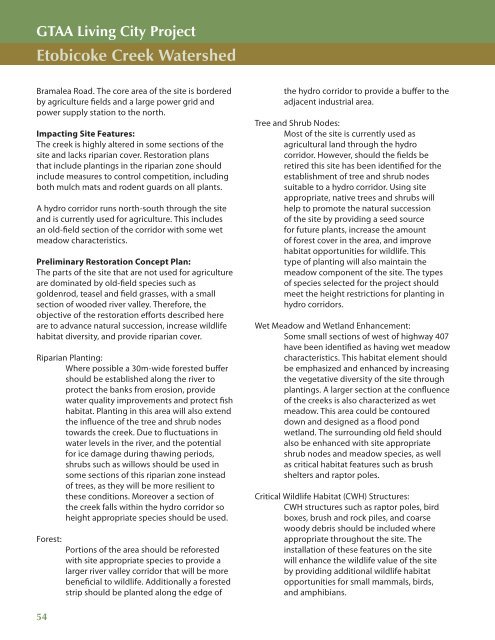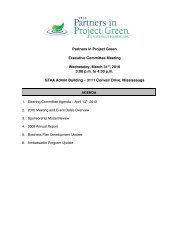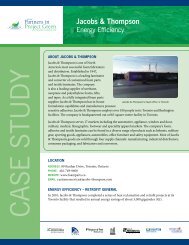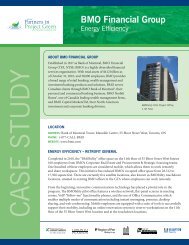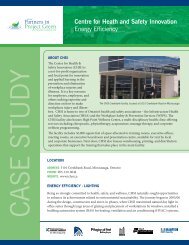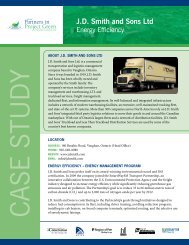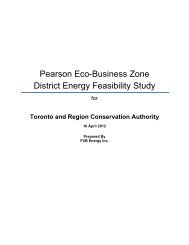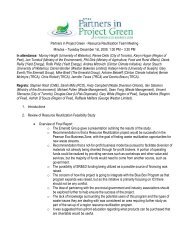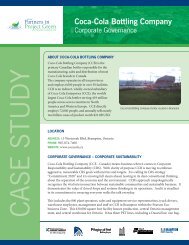Summary Report and Implementation Plan - Partners in Project Green
Summary Report and Implementation Plan - Partners in Project Green
Summary Report and Implementation Plan - Partners in Project Green
Create successful ePaper yourself
Turn your PDF publications into a flip-book with our unique Google optimized e-Paper software.
GTAA Liv<strong>in</strong>g City <strong>Project</strong><br />
Integration Etobicoke Creek <strong>and</strong> <strong>Implementation</strong><br />
Watershed<br />
Bramalea Road. The core area of the site is bordered<br />
by agriculture fields <strong>and</strong> a large power grid <strong>and</strong><br />
power supply station to the north.<br />
Impact<strong>in</strong>g Site Features:<br />
The creek is highly altered <strong>in</strong> some sections of the<br />
site <strong>and</strong> lacks riparian cover. Restoration plans<br />
that <strong>in</strong>clude plant<strong>in</strong>gs <strong>in</strong> the riparian zone should<br />
<strong>in</strong>clude measures to control competition, <strong>in</strong>clud<strong>in</strong>g<br />
both mulch mats <strong>and</strong> rodent guards on all plants.<br />
A hydro corridor runs north-south through the site<br />
<strong>and</strong> is currently used for agriculture. This <strong>in</strong>cludes<br />
an old-field section of the corridor with some wet<br />
meadow characteristics.<br />
Prelim<strong>in</strong>ary Restoration Concept <strong>Plan</strong>:<br />
The parts of the site that are not used for agriculture<br />
are dom<strong>in</strong>ated by old-field species such as<br />
goldenrod, teasel <strong>and</strong> field grasses, with a small<br />
section of wooded river valley. Therefore, the<br />
objective of the restoration efforts described here<br />
are to advance natural succession, <strong>in</strong>crease wildlife<br />
habitat diversity, <strong>and</strong> provide riparian cover.<br />
Riparian <strong>Plan</strong>t<strong>in</strong>g:<br />
Where possible a 30m-wide forested buffer<br />
should be established along the river to<br />
protect the banks from erosion, provide<br />
water quality improvements <strong>and</strong> protect fish<br />
habitat. <strong>Plan</strong>t<strong>in</strong>g <strong>in</strong> this area will also extend<br />
the <strong>in</strong>fluence of the tree <strong>and</strong> shrub nodes<br />
towards the creek. Due to fluctuations <strong>in</strong><br />
water levels <strong>in</strong> the river, <strong>and</strong> the potential<br />
for ice damage dur<strong>in</strong>g thaw<strong>in</strong>g periods,<br />
shrubs such as willows should be used <strong>in</strong><br />
some sections of this riparian zone <strong>in</strong>stead<br />
of trees, as they will be more resilient to<br />
these conditions. Moreover a section of<br />
the creek falls with<strong>in</strong> the hydro corridor so<br />
height appropriate species should be used.<br />
Forest:<br />
Portions of the area should be reforested<br />
with site appropriate species to provide a<br />
larger river valley corridor that will be more<br />
beneficial to wildlife. Additionally a forested<br />
strip should be planted along the edge of<br />
the hydro corridor to provide a buffer to the<br />
adjacent <strong>in</strong>dustrial area.<br />
Tree <strong>and</strong> Shrub Nodes:<br />
Most of the site is currently used as<br />
agricultural l<strong>and</strong> through the hydro<br />
corridor. However, should the fields be<br />
retired this site has been identified for the<br />
establishment of tree <strong>and</strong> shrub nodes<br />
suitable to a hydro corridor. Us<strong>in</strong>g site<br />
appropriate, native trees <strong>and</strong> shrubs will<br />
help to promote the natural succession<br />
of the site by provid<strong>in</strong>g a seed source<br />
for future plants, <strong>in</strong>crease the amount<br />
of forest cover <strong>in</strong> the area, <strong>and</strong> improve<br />
habitat opportunities for wildlife. This<br />
type of plant<strong>in</strong>g will also ma<strong>in</strong>ta<strong>in</strong> the<br />
meadow component of the site. The types<br />
of species selected for the project should<br />
meet the height restrictions for plant<strong>in</strong>g <strong>in</strong><br />
hydro corridors.<br />
Wet Meadow <strong>and</strong> Wetl<strong>and</strong> Enhancement:<br />
Some small sections of west of highway 407<br />
have been identified as hav<strong>in</strong>g wet meadow<br />
characteristics. This habitat element should<br />
be emphasized <strong>and</strong> enhanced by <strong>in</strong>creas<strong>in</strong>g<br />
the vegetative diversity of the site through<br />
plant<strong>in</strong>gs. A larger section at the confluence<br />
of the creeks is also characterized as wet<br />
meadow. This area could be contoured<br />
down <strong>and</strong> designed as a flood pond<br />
wetl<strong>and</strong>. The surround<strong>in</strong>g old field should<br />
also be enhanced with site appropriate<br />
shrub nodes <strong>and</strong> meadow species, as well<br />
as critical habitat features such as brush<br />
shelters <strong>and</strong> raptor poles.<br />
Critical Wildlife Habitat (CWH) Structures:<br />
CWH structures such as raptor poles, bird<br />
boxes, brush <strong>and</strong> rock piles, <strong>and</strong> coarse<br />
woody debris should be <strong>in</strong>cluded where<br />
appropriate throughout the site. The<br />
<strong>in</strong>stallation of these features on the site<br />
will enhance the wildlife value of the site<br />
by provid<strong>in</strong>g additional wildlife habitat<br />
opportunities for small mammals, birds,<br />
<strong>and</strong> amphibians.<br />
54


